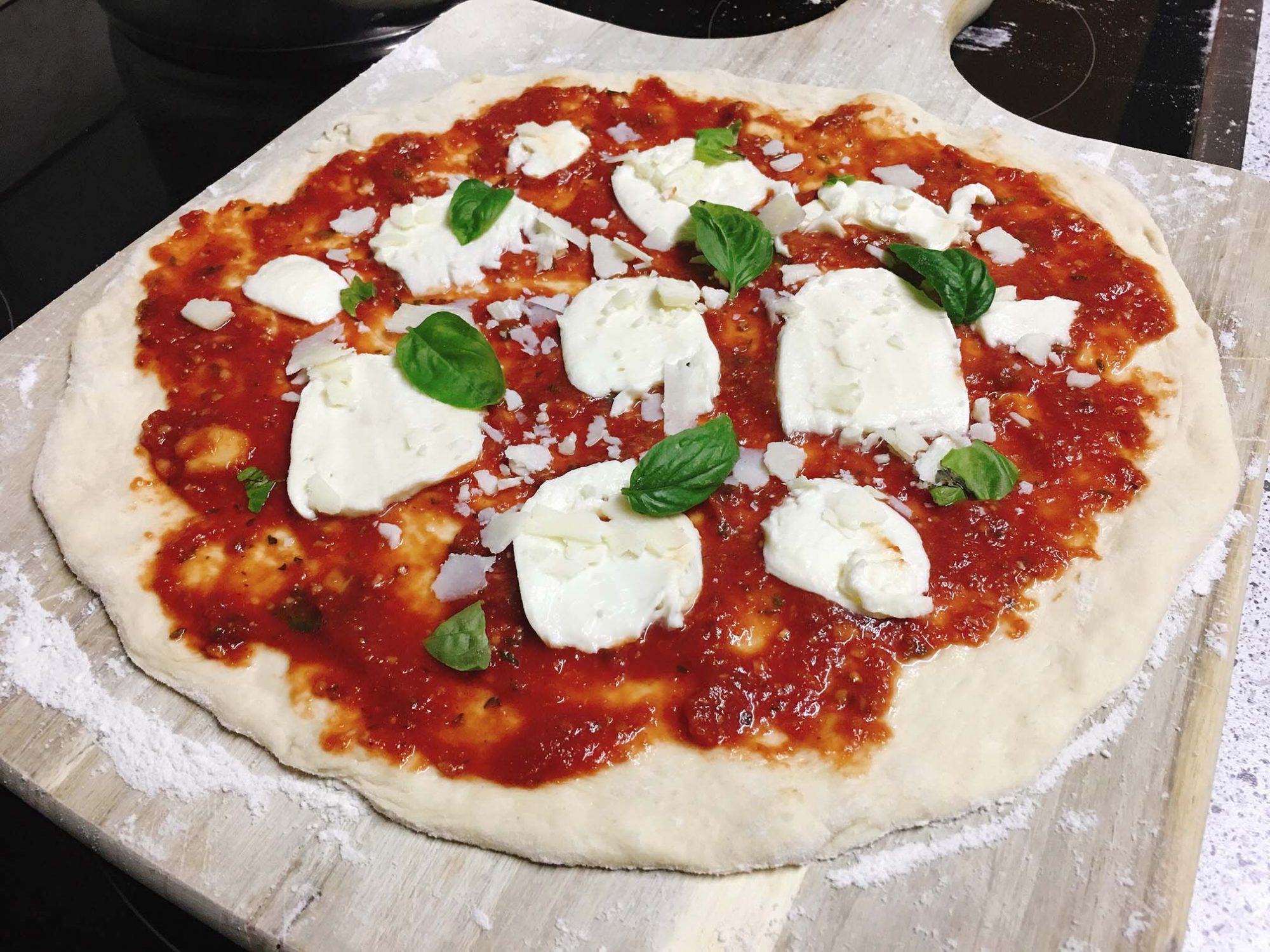Embark on a culinary adventure with our authentic Italian pizza dough recipe, a yeast-free masterpiece that will transport your taste buds to the heart of Italy. With its simple yet exquisite ingredients and time-honored techniques, this dough will elevate your pizza-making skills to new heights, allowing you to create mouthwatering pizzas that rival those of the finest pizzerias.
The absence of yeast in this recipe gives the dough a unique character, resulting in a crispy crust with a chewy interior. It is a testament to the ingenuity of Italian cuisine, where simplicity and authenticity reign supreme. By following our step-by-step instructions and embracing the nuances of the dough’s behavior, you will not only master the art of pizza-making but also gain a deeper appreciation for the culinary traditions of Italy.
Ingredients

Creating an authentic Italian pizza dough without yeast requires a specific set of ingredients that work together to achieve the desired texture, flavor, and aroma.
Each ingredient plays a crucial role in the dough’s development and final characteristics:
Flour
- High-quality, double-zero (00) Italian flour is essential for its fine texture and high protein content.
- The high protein content helps the dough develop gluten, which gives it strength and elasticity.
Water
- Water activates the gluten in the flour and helps form the dough’s structure.
- The amount of water used will affect the dough’s hydration level, which impacts its texture and elasticity.
Salt
- Salt adds flavor to the dough and helps strengthen the gluten.
- It also helps control the dough’s fermentation and prevents it from becoming too sticky.
Extra Virgin Olive Oil
- Extra virgin olive oil adds flavor and richness to the dough.
- It also helps keep the dough moist and prevents it from drying out during baking.
Baking Powder
- Baking powder is a leavening agent that helps the dough rise slightly.
- It is important to use the correct amount of baking powder, as too much can result in a bitter taste.
Steps to Make the Dough
Making the dough is a crucial step in creating the perfect Italian pizza. Here are the detailed instructions to guide you through the process:
Mixing
In a large bowl, combine the flour, salt, and water. Mix until the ingredients are just combined and form a shaggy dough. Do not overmix at this stage.
Kneading
Turn the dough out onto a lightly floured surface and knead for 5-7 minutes until it becomes smooth and elastic. The dough should be firm enough to handle but not too dry or sticky.
Resting
Once the dough is kneaded, form it into a ball and place it in a lightly oiled bowl. Cover the bowl with plastic wrap and let the dough rest for at least 30 minutes at room temperature. This allows the gluten to relax and makes the dough easier to work with.
Tips for Achieving Authenticity
Authentic Italian pizza dough requires attention to detail and the use of high-quality ingredients. To achieve the best results, consider the following tips:
Choosing Ingredients
Use high-quality, double-zero flour (00 flour) for a fine and elastic dough. The higher protein content in 00 flour creates a stronger gluten network, resulting in a chewy crust. Use fine sea salt to enhance the dough’s flavor without overpowering it.
Kneading Technique
Kneading develops the gluten network in the dough, creating a strong and elastic structure. Knead by hand for at least 10 minutes or use a stand mixer with a dough hook. The dough should become smooth and elastic, not sticky or too dry.
Resting Time
Resting allows the dough to relax and develop its flavor. Cover the dough and let it rest at room temperature for at least 1 hour, or refrigerate it for up to 24 hours. This resting period allows the yeast to activate and the flavors to meld.
Variations

The basic pizza dough recipe can be varied to create different flavors and textures. Here are a few popular variations:
Adding Herbs and Spices: Adding herbs and spices to the dough can enhance its flavor. Popular herbs and spices include oregano, basil, rosemary, garlic powder, and onion powder. These ingredients can be added to the dough during mixing or sprinkled on top before baking.
Different Types of Flour
- Whole Wheat Flour: Using whole wheat flour instead of all-purpose flour creates a dough that is higher in fiber and has a nuttier flavor. However, it may require more water and kneading to achieve the desired consistency.
- Rye Flour: Rye flour adds a slightly sour flavor to the dough and creates a denser texture. It is often combined with all-purpose flour to balance the flavors and textures.
- Spelt Flour: Spelt flour is an ancient grain that creates a dough that is light and airy. It has a slightly sweet flavor and is a good choice for those who are intolerant to wheat.
Troubleshooting
While crafting the ideal pizza dough, you may encounter a few hurdles. Let’s dive into some common problems and their solutions to help you overcome these obstacles and achieve pizza perfection.
Dough is Too Sticky
- Add more flour gradually, working it into the dough until it becomes less sticky but still remains pliable.
- Avoid overworking the dough, as this can develop gluten and make it tough.
Dough is Too Dry
- Gradually add water, 1 tablespoon at a time, and knead until the dough comes together and forms a ball.
- Ensure the water is at room temperature to prevent shocking the yeast.
Dough Doesn’t Rise Properly
- Check the expiration date of the yeast and ensure it’s still active.
- Make sure the water temperature is not too hot or too cold, as this can kill or inhibit the yeast.
- Give the dough ample time to rise in a warm, draft-free environment.
Presentation
Presenting your homemade Italian pizza dough is an essential step in the culinary experience. Not only does it enhance the visual appeal, but it also allows you to showcase your culinary skills and creativity.
To create a visually appealing presentation, consider using a rustic serving platter or a wooden cutting board. Arrange the pizza dough in a circular shape, ensuring it is evenly distributed and free from any tears or imperfections. You can also add a touch of elegance by sprinkling some fresh herbs, such as basil or oregano, around the dough’s edges.
Shaping the Dough
The shape of your pizza dough can greatly influence its presentation. For a classic Italian look, opt for a round shape. To achieve this, gently stretch the dough into a circle, ensuring the edges are slightly thicker than the center.
You can also create a more rustic look by shaping the dough into an oval or rectangular form. Simply stretch the dough into the desired shape, ensuring the edges are slightly raised.
Last Word
As you savor each bite of your homemade pizza, crafted with an authentic Italian pizza dough without yeast, you will not only satisfy your hunger but also experience a profound connection to the rich culinary heritage of Italy. This recipe is more than just a collection of ingredients and instructions; it is a gateway to a world of flavors, textures, and culinary artistry.
We encourage you to experiment with variations, such as adding herbs, spices, or different types of flour, to create pizzas that reflect your unique taste and creativity. Embrace the joy of pizza-making, and let this authentic dough be the foundation of your culinary adventures.
FAQs
Can I use active dry yeast instead of the yeast substitute?
No, using active dry yeast will alter the flavor and texture of the dough, as it will introduce a fermented taste and a different rising mechanism.
Why is it important to let the dough rest before shaping it?
Resting the dough allows the gluten to relax, making it easier to shape and preventing it from shrinking back in the oven.
What is the ideal temperature for the water when mixing the dough?
Lukewarm water (around 105-115°F or 40-46°C) is ideal, as it activates the enzymes in the flour without killing them.
Can I use a food processor to mix the dough?
While you can use a food processor to combine the ingredients, it is recommended to knead the dough by hand to develop the gluten and achieve the desired texture.
